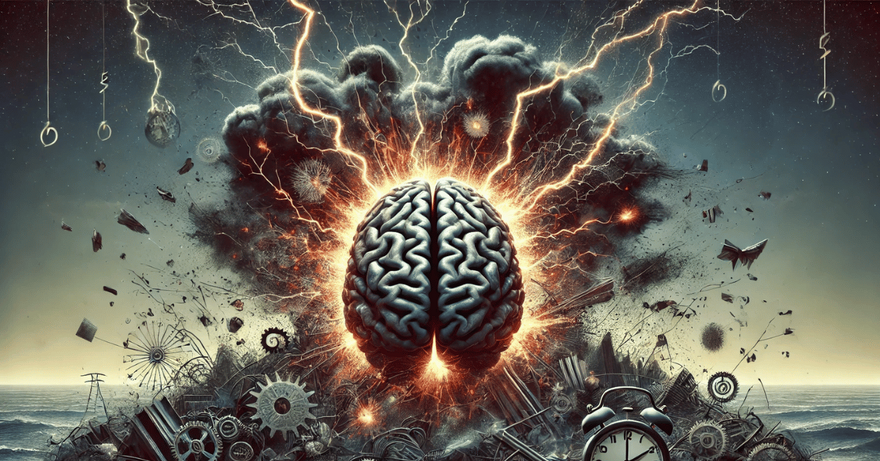Yoga of Mental Health Workshops → More Info
How Stress Wrecks Your Brain (and How Yoga and Meditation Can Restore Brain Health)

This article is divided into two parts.
- The first is about how chronic, unresolved stress wrecks your brain.
- The second is about how yoga and meditation repair the damage of chronic stress. This part describes the four stages of repair, moving from basic repair of the damage to stabilizing normal function, then building a stronger neural architecture, and finally, the phase of mastery in which you optimize brain function.
Stress is an unavoidable part of life. While acute, short-term stress helps you cope with challenging situations, chronic, long-term, unresolved stress is different. Long-term stress doesn’t just deplete your energy and affect your mood; it damages your ability to think clearly, process information, and handle emotions.
Chronic stress wrecks your brain—it physically reshapes it, changing the size, structure, and function of parts of it. Over time, persistent stress alters neural structures, shrinks key regions involved in memory and decision-making, and overactivates the parts involved in emotional control.
While these changes often develop slowly and are initially subtle, their effects can profoundly impact cognitive function, emotional well-being, and behavior patterns throughout life.
The key takeaway
Chronic, unresolved stress creates an imbalance between the self-aware, rational, decision-making, and problem-solving parts of the brain (the pre-frontal cortex) and the emotion and memory-controlling parts of the brain (the amygdala and hippocampus)

The good news?
Yoga and meditation offer practical tools to reverse this damage and restore balance to the brain and mind.
Integrating yoga and meditation into your life can help you repair the damaging effects of stress on the brain and increase mental and emotional resilience.
How Stress Wrecks Your Brain
When we experience stress, the body releases hormones like cortisol and adrenaline, preparing us for a “fight or flight” response. This response is helpful in short bursts—like when you’re faced with a pressing deadline or need to respond quickly in an emergency. But when stress becomes chronic, the brain is continually flooded with these hormones, leading to long-term harm.
Key Areas of the Brain Affected by Chronic Stress
Stress wrecks your brain by impairing the function of three critical areas:
- Hippocampus (Memory and Learning)
The hippocampus is responsible for memory formation and learning. High cortisol levels shrink the hippocampus, impairing our ability to form and retain memories. Over time, this damage can affect our capacity to learn new things and recall important information. - Amygdala (Emotional Responses)
The amygdala controls our emotional reactions, particularly fear and anxiety. Chronic stress overactivates the amygdala, making us more prone to feeling anxious, fearful, or irritable. Stress makes it difficult to regulate feelings, increasing the likelihood of emotional overreactions. - Prefrontal Cortex (Decision-Making and Focus)
The prefrontal cortex is the part of the brain that governs cognition, self-awareness, focus, attention, decision-making, and self-control. Under chronic stress, these prefrontal cortex functions are impaired, making it harder to focus, think critically, and make good decisions. This is why stressed-out people often feel scatterbrained or have trouble staying organized. Also, the overactive amygdala hijacks the pre-frontal cortex, making us more reactive and less responsive.
Your emotional, instinctive brain expands.
The amygdala is concerned with processing emotions and modulating our most primitive instincts, such as survival, sex, fear, and aggression. Chronic stress actually causes the amygdala to increase in size.
A bigger amygdala is correlated with aggression. Our emotions can override our ability to think clearly. We become more impulsive, angry, and impatient. Our emotions easily take over, driving us to react to life circumstances in ways that do not serve us or others well. We feel overwhelmed and out of control.
Consider a common parenting scenario: when chronically stressed, you're more likely to respond to a child's misbehavior with angry outbursts rather than thoughtful guidance. This happens because prolonged stress impairs your brain's executive function—the rational 'brake system' that normally helps us pause, think, and choose constructive responses. When stress overwhelms this crucial cognitive control, your emotional reactions take over, leading to behaviors you later regret.
Your thinking brain is destabilized.
The pre-frontal cortex, the brain's outer layer, which is also the most evolved part of your brain, is the region most sensitive to the detrimental effects of stress exposure. Even quite mild acute stress can cause a rapid and dramatic loss of prefrontal cognitive abilities, and more prolonged stress exposure causes architectural changes in the nerves (dendrites) in the prefrontal cortex.
The prefrontal cortex subserves higher-order cognitive functions. It enables you to stop and think in a crisis, to access your memories, experience, and wisdom, and it can do this in a fraction of a second if it is turned on, functioning well, and harmoniously relating to the other areas of the brain. This lets you assess your situation and intuit how to react appropriately to your treasured but screaming child.
The prefrontal cortex enables us to gain perspective and put ourselves in other people’s shoes to have empathy. However, when chronic stress takes hold:
- We become more narcissistic, losing our capacity for empathy
- We lose our capacity for objectivity and insight.
- Because we can’t think clearly, we may tend to catastrophize, to see things as being a lot worse than they are.
- We might displace blame inappropriately onto others rather than taking responsibility ourselves.
How Stress Feeds a Vicious Cycle
As stress continues, these effects can create a vicious cycle where the brain becomes less capable of handling stress, leading to even more damage and suffering over time. The risk of developing anxiety, depression, and cognitive decline is increased.
How? Well, the more stressed you are, the harder it becomes for your brain to cope with daily life. Over time, stress weakens your ability to manage stress, creating a feedback loop where stress becomes harder and harder to shake. You may find yourself stuck in a cycle of racing thoughts, irritability, anxiety, and fatigue. This cycle not only affects your mental health but also increases the risk of developing severe health conditions, including depression, anxiety disorders, and even neurodegenerative diseases like Alzheimer’s.
The Impact of Chronic Stress on Overall Health
Chronic stress doesn't just wreak havoc on your brain but also significantly affects your overall health. When stress becomes a constant companion, your body remains in a heightened state of alert, leading to a variety of physical and mental health issues.
Physical Health Consequences
-
Cardiovascular Problems: Persistent stress increases your heart rate and blood pressure, putting extra strain on your heart and blood vessels. Over time, this can elevate the risk of hypertension, heart attacks, and strokes.
-
Weakened Immune System: Chronic stress suppresses the immune system, making you more susceptible to infections and illnesses. It can also slow the body’s healing processes, prolonging recovery from injuries or surgeries.
-
Digestive Issues: Stress can disrupt your digestive system, leading to indigestion, irritable bowel syndrome (IBS), and ulcers. It affects how your body processes food, potentially causing poor nutrient absorption.
-
Musculoskeletal Tension: Prolonged stress causes muscles to remain tense, leading to headaches, migraines, and chronic pain conditions such as back pain and arthritis exacerbations.
-
Long-Term Health Risks: If left unmanaged, chronic stress can contribute to the development of severe health conditions such as diabetes, obesity, and autoimmune diseases. It also accelerates aging, leading to a prematurely weakened physical state.
Mental and Emotional Health Consequences
-
Anxiety and Depression: Constant stress can lead to persistent feelings of anxiety and depression. It affects neurotransmitter levels in the brain, which are crucial for regulating mood and emotional responses.
-
Sleep Disorders: Stress often disrupts sleep patterns, resulting in insomnia or poor-quality sleep. Lack of restful sleep further impairs cognitive function and emotional stability, creating a vicious cycle of stress and fatigue.
-
Cognitive Decline: Beyond memory and decision-making, chronic stress can impair concentration, reduce mental clarity, and decrease overall cognitive performance. This makes it challenging to perform daily tasks efficiently and can hinder personal and professional growth.
Breaking the Cycle with Yoga and Meditation
Understanding the extensive impact of chronic stress on both your brain and overall health underscores the importance of effective stress management practices. Incorporating yoga and meditation into your daily routine provides a holistic approach to mitigating these adverse effects. These practices help repair the brain and support physical health by reducing inflammation, improving cardiovascular function, and enhancing immune response.
By addressing both mental and physical aspects of stress, yoga and meditation empower you to lead a healthier, more balanced life.

How Yoga and Meditation Repair the Damage of Chronic Stress
Yoga and meditation offer natural ways to counteract these effects and heal your brain.
Learning to relax and eventually becoming a more relaxed person is the key to successfully repairing the effects of stress and stopping stress from wrecking your brain. Once you have learned to relax, you can progress to more advanced yoga-tantra techniques that accelerate healing and enable access to powerfully life-affirming inner experiences.
How Yoga Heals the Brain
Yoga-tantra is much more than physical exercise. It is a holistic practice combining yoga postures with self-awareness, mindfulness, relaxation, breath control, and extremely powerful meditation techniques. These techniques utilize mantras, visualizations, and other methods that offer wonderful benefits for brain health, emotional well-being, and spiritual awakening.
Learning to relax is the first step in healing the brain and restoring health. Relaxation:
- Reduces Cortisol Levels: Regular yoga and meditation lowers cortisol levels, protecting the hippocampus and prefrontal cortex from further damage. This helps maintain memory and cognitive function, allowing your brain to recover from the harmful effects of stress.
- Enhances Focus and Concentration: Yoga combines postures and breath awareness to develop health and improve focus and concentration. By training your mind to stay present, yoga rebuilds prefrontal cortex function, allowing you to think more clearly and make better decisions.
- Balances Emotional Responses: Yoga also helps regulate emotional reactions by calming the amygdala. This leads to greater emotional stability, helping you manage stress and anxiety.
Brain Research on Meditation and the Brain
Yoga-tantra can repair stress-related brain damage and restore mental clarity and emotional balance. Yoga-tantra meditations stimulate your brain to grow new neurons and restore functions. This is because the brain has a degree of plasticity. It just needs the correct conditions to restore health and the brain's functions.
Meditation, like yoga, has been scientifically proven to profoundly affect brain structure and function, particularly in repairing the damage caused by chronic stress. Techniques such as those in the Three Easy Steps to Deep Relaxation and more powerful techniques such as Ajapa Japa are especially powerful in cultivating the following benefits:
-
Strengthens the Prefrontal Cortex
Research has shown that meditation increases the thickness of grey matter in the prefrontal cortex, enhancing your ability to focus, make decisions, and remain calm under pressure. This helps rebuild the brain’s capacity to handle stress more effectively. -
Shrinks the Amygdala
Research has shown that regular meditation reduces the size and activity of the amygdala, lowering emotional reactivity. This means you’re less likely to be overwhelmed by stress and can respond to challenges with greater emotional balance. - Enhances the connectivity between the prefrontal cortex and the amygdala
Meditation is believed to enhance connectivity between the prefrontal cortex and the amygdala. This is because meditation improves prefrontal cortex (PFC) functions like cognition, self-awareness, attention, and memory and reduces psychological and emotional symptoms.
-
Promotes Mindfulness and Awareness
Meditation teaches you to observe your thoughts without becoming entangled in them. By cultivating mindfulness, you become more aware of how stress affects you, which helps you break the cycle of stress before it takes control.
Together, these changes help rewire the brain, allowing you to experience greater peace of mind and emotional resilience in the face of stress.
The Long-Term Benefits of Yoga and Meditation
The effects of yoga and meditation go beyond immediate relief from stress. Over time, they help create a brain that is more adaptable, resilient, and capable of thriving even in challenging circumstances.
-
Protection Against Cognitive Decline: Regularly stimulating the brain through mindful practices reduces the risk of age-related cognitive decline and conditions like Alzheimer’s. Yoga and meditation keep your brain active, healthy, and sharp well into old age.
-
Better Decision-Making: With a strengthened prefrontal cortex, you’ll make more thoughtful, balanced decisions. Whether in your personal life or professional environment, these practices give you the mental clarity and focus to act in alignment with your goals and values.
-
Greater Emotional Resilience:
Yoga and meditation cultivate mindfulness and emotional balance so you better handle life’s challenges with grace and calm. Instead of being overwhelmed by stress or negative emotions, you’ll develop a steady, resilient mind that can face difficulties with confidence.
How Meditation Optimizes the Brain
Progressive Journey to Resilience: From Repair to Growth
The journey from stress management to true resilience is like building a house - you need a solid foundation before adding more complex structures.
The journey begins with crucial repair work - like rehabilitating an injured muscle. We must first heal the damage caused by chronic stress to our brain and nervous system.
The initial stress management and relaxation techniques actively reverse the neural degeneration caused by chronic stress, helping to restore normal function to the hippocampus and prefrontal cortex.
Once this foundational healing is established, we can begin building stronger neural pathways and enhanced brain function. This is similar to an athlete who first recovers from injury and then builds greater strength than before.
The brain's neuroplasticity allows us not just to return to baseline but to develop greater cognitive reserves and emotional resilience than we had previously. This progression creates a positive feedback loop where each new skill we master not only prevents future stress damage but actively contributes to building a more robust and resilient brain structure.
The journey from repair to mastery has 4 main phases.
Phase 1 – The Initial Repair Phase: Addressing Stress Damage
The initial repair phase is crucial as it focuses on reversing the physical damage chronic stress inflicted on the brain.
At this stage, stress hormones like cortisol remain chronically elevated. Let's quickly summarize the stress-induced alterations in the brain:
- The prefrontal cortex has experienced dendrite retraction, meaning the neural connections have literally shrunk back, reducing our ability to think clearly and make good decisions.
- The hippocampus, our memory center, has decreased both in function and actual size. There is reduced neurogenesis, growth of new cells, and actual volume loss.
- The amygdala, our fear and emotional center, has become enlarged and hyperactive. These changes create a brain state where we're more reactive, less thoughtful, and struggling with memory and focus.
So, what do we do to stop this degeneration?
During this phase, we introduce gentle, foundational practices designed to begin reversing these changes. Deep relaxation techniques are particularly important as they directly lower cortisol levels, allowing the brain to begin repair processes.
Our Three Easy Steps to Relaxation guided meditation series teaches us how to break the physical stress cycle by activating the parasympathetic nervous system, the part of the brain that controls rest and repair. This part of the brain is turned off due to chronic stress. It is actually stuck in overactivity, driven by the amygdala and the unpleasant feelings it is generating.
To enhance repair and healing, we use the breath and mindfulness, which are part of the Three Easy Steps program. These practices have a primary effect on the amygdala, calming its overactivity.
Another essential technique at this time is Yoga Nidra, especially the form of Yoga Nidra that focuses on improving our ability to handle feelings.
Adding some asanas (yoga poses and stretching) to remove physical stress and muscular tension is a great idea.
The results of this phase are measurable and encouraging. We typically see reductions in cortisol levels, normalization of blood pressure and heart rate, and improved sleep quality.
Many of our students and patients report their first significant reduction in anxiety symptoms and notice their attention span is beginning to improve. These changes provide the stable foundation necessary for deeper work.
Phase 2 – The Stabilization Phase: Restoring Normal Function
As the initial repair phase shifts to phase 2, the stabilization phase, the brain begins a fascinating process of reorganization:
- Neural pruning begins to remove the unhealthy pathways created during chronic stress,
- The hippocampus starts resuming its normal memory and learning functions.
- The previously hyperactive amygdala begins to calm down.
- We see the first signs of new neural growth in the prefrontal cortex - our center of executive function.
During this phase, it is a good idea to add techniques such as Ajapa Japa and meditations on the third eye of intuition, which powerfully and positively stimulate the brain and nervous system. These techniques incorporate both relaxation and more focused attention. The addition of concentration meditations, such as the purification of the third eye chakra, ajna, is very powerful and effective for restoring brain function.
These more advanced practices actively build new neural connections and strengthen existing ones. They increase gray matter density in regions associated with self-awareness and emotional regulation. Advanced meditation techniques like Ajapa Japa combined with self-awareness and mindfulness can actually increase cortical thickness in areas associated with attention and sensory processing.
In this phase, we are moving towards concentration meditations that strengthen attention. The introduction of yoga postures with mindfulness helps integrate physical and mental awareness, creating more robust neural pathways.
The outcomes during this phase are particularly encouraging as practitioners report
- Improved emotional regulation
- Better short-term memory function
- Notably reduced reactivity to stressors
- Energy levels become more consistent
- There are significant improvements in our ability to focus and concentrate.
These changes indicate that the brain is not just repairing but beginning to optimize its function.
Phase 3 – The Enhancement Phase: Building Stronger Neural Architecture
This third phase marks an exciting transition from repair to enhancement, where the brain develops capabilities beyond its original baseline.
- Neuroplasticity increases significantly, allowing for the rapid formation of new neural pathways.
- The connectivity between different brain regions becomes more sophisticated, and we see measurable growth in gray matter density, particularly in areas associated with attention, emotional regulation, and self-awareness.
- The white matter, which enables efficient communication between brain regions, shows improved integrity,
- and the default mode network - crucial for self-reflection and emotional processing - becomes more refined.
As our ability to meditate improves and we feel less detrimented and exhausted by chronic stress, we can engage in sophisticated visualization practices that activate multiple brain regions simultaneously.
During this phase, we are ready for more advanced forms of Ajapa Japa meditation, which combine mantra, breath awareness, and visualization to create complex neural integration.
Yoga poses that require balance and challenge our nervous system are incredibly useful at this stage. They serve a dual purpose - they not only improve physical balance but also enhance neural integration. They strengthen connections between brain hemispheres and create robust new neural networks.
The results at this stage are remarkable:
- We develop superior emotional intelligence, allowing us to more gracefully navigate complex emotional situations.
- Our problem-solving abilities show marked improvement, and cognitive flexibility - the ability to adapt thinking to new situations - becomes notably enhanced.
- Stress resilience reaches new levels, and many practitioners report increased creativity and insight in both personal and professional contexts.
Phase 4 – The Mastery Phase: Optimizing Brain Function
The final phase is the mastery phase, which represents a level of neural integration and efficiency that researchers have observed in experienced meditators.
- The brain shows patterns of activity that differ significantly from the average population.
- The connectivity between brain regions becomes highly sophisticated, enabling rapid and efficient processing of information and emotions.
- Neurogenesis (the creation of new brain cells) and the production of BDNF (brain-derived neurotrophic factor) remain elevated, supporting continued growth and repair.
- Cellular repair mechanisms function optimally,
- and the brain demonstrates remarkable efficiency in energy use and information processing, called neural efficiency.
At this stage,
- We can engage in extended meditation retreats that create lasting positive changes in brain structure and function.
- Advanced pranayama practices fine-tune the nervous system
- The integration of multiple techniques creates synergistic benefits.
- Many students become teachers at this stage. Teaching others is a powerful way to enhance the integration of areas of the brain and our understanding and experience of yoga and meditation.
- At this stage, practices become highly personalized and adapted to individual needs and goals while maintaining core principles.
The outcomes include
- Exceptional emotional regulation abilities so that we can maintain our composure even in extremely challenging situations
- Stress resilience reaches remarkable levels.
- Cognitive performance under pressure shows significant enhancement.
- Longevity markers improve.
- We experience sustained mental clarity and insight.
Phase 5 - Long-term Maintenance and Growth
There is a fifth phase, which is basically the phase in which we focus on sustaining and building upon the gains achieved in the last four phases while at the same time protecting ourselves against age-related decline. During this phase we aim to
- The brain maintains enhanced neural structures and demonstrates remarkable neuroplasticity even with aging.
- Cognitive reserve - the brain's resilience against aging and damage - remains robust.
- The brain-body communication systems function optimally, supporting overall health and longevity.
Practices in this phase focus on maintaining vitality and continued growth through regular daily meditation practice.
The long-term outcomes are particularly impressive:
- We maintain high cognitive function well into older age, demonstrating that these practices not only enhance current function but also provide protection against age-related decline.
- Our quality of life remains high
- Resilience stays robust
- We can develop profound emotional wisdom
- Social connections strengthen, creating a supportive environment for continued growth and development.
This complete progression from repair to mastery represents a comprehensive approach to not just brain health, but overall life enhancement. Each phase builds upon the previous one, creating a robust foundation for both immediate well-being and long-term flourishing.
Learn Relaxation Meditation Techniques For Stress Reduction
If you want to increase relaxation, regain your health, prevent illness, master stress reduction, and rebalance your brain, we highly recommend enrolling in Big Shakti's Relaxation Meditation Course.
The course is suitable for anyone who wants to develop a healthy relaxation baseline, build natural immunity, and prevent stress-based illnesses. It is also recommended as fundamental training for yoga-meditation students and teachers.
Relaxation is the foundation of all successful meditation. You will receive authentic training that combines yoga, meditation, and Western medical knowledge. This powerful combination brings deep, embodied healing.
Categories
- Yoga (13)
- Yoga Tantra (20)
- Meditation (23)
- Meditation Techniques (31)
- Ayurveda (3)
- Carl Jung (5)
- Chakras (14)
- Consciousness (17)
- Diseases (7)
- e-mag (9)
- Everyday Wisdom (6)
- Life Purpose (8)
- Mantras (18)
- Mental Wellness (44)
- Podcast (23)
- Prana - The subtle breath (14)
- Relaxation (18)
- Shadow Self (7)
- Spirituality (12)
- Symbols (2)
- Third Eye - Ajna Chakra (7)
- Wisdom (2)
- Yoga Nidra (12)
- Yoga Philosophy (16)
- Yoga Psychology (19)
- Yoga Therapy (41)
- Yoga Meditation Research (3)
- Articles by Jayne Stevenson (14)
- Articles by Swami Shankardev (25)
- Stress Management (11)
- Emotion (3)
- Self-Awareness (1)
- Self-Regulation (1)
- Healing (3)
2025 Yoga of Mental Health Workshops
- Sāṁkhya Philosophy & Mental Health: A Yogic Path to Holistic Well-being
- Uncovering the Roots of Mental Illness: Insights from the Gita & Patanjali
- Restoring Self-Regulation: Yogic Techniques for Emotional Resilience & Inner Strength
- Mantra Therapy: Transforming Thought Patterns for Emotional Healing & Mental Wellbeing







